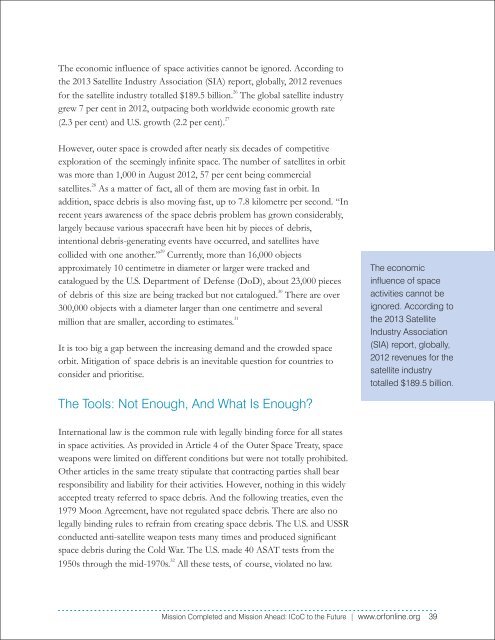AwaitingLaunch_1397728623369
AwaitingLaunch_1397728623369
AwaitingLaunch_1397728623369
Create successful ePaper yourself
Turn your PDF publications into a flip-book with our unique Google optimized e-Paper software.
The economic influence of space activities cannot be ignored. According to<br />
the 2013 Satellite Industry Association (SIA) report, globally, 2012 revenues<br />
26<br />
for the satellite industry totalled $189.5 billion. The global satellite industry<br />
grew 7 per cent in 2012, outpacing both worldwide economic growth rate<br />
27<br />
(2.3 per cent) and U.S. growth (2.2 per cent).<br />
However, outer space is crowded after nearly six decades of competitive<br />
exploration of the seemingly infinite space. The number of satellites in orbit<br />
was more than 1,000 in August 2012, 57 per cent being commercial<br />
28<br />
satellites. As a matter of fact, all of them are moving fast in orbit. In<br />
addition, space debris is also moving fast, up to 7.8 kilometre per second. “In<br />
recent years awareness of the space debris problem has grown considerably,<br />
largely because various spacecraft have been hit by pieces of debris,<br />
intentional debris-generating events have occurred, and satellites have<br />
29<br />
collided with one another.” Currently, more than 16,000 objects<br />
approximately 10 centimetre in diameter or larger were tracked and<br />
catalogued by the U.S. Department of Defense (DoD), about 23,000 pieces<br />
30<br />
of debris of this size are being tracked but not catalogued. There are over<br />
300,000 objects with a diameter larger than one centimetre and several<br />
31<br />
million that are smaller, according to estimates.<br />
It is too big a gap between the increasing demand and the crowded space<br />
orbit. Mitigation of space debris is an inevitable question for countries to<br />
consider and prioritise.<br />
The economic<br />
influence of space<br />
activities cannot be<br />
ignored. According to<br />
the 2013 Satellite<br />
Industry Association<br />
(SIA) report, globally,<br />
2012 revenues for the<br />
satellite industry<br />
totalled $189.5 billion.<br />
The Tools: Not Enough, And What Is Enough?<br />
International law is the common rule with legally binding force for all states<br />
in space activities. As provided in Article 4 of the Outer Space Treaty, space<br />
weapons were limited on different conditions but were not totally prohibited.<br />
Other articles in the same treaty stipulate that contracting parties shall bear<br />
responsibility and liability for their activities. However, nothing in this widely<br />
accepted treaty referred to space debris. And the following treaties, even the<br />
1979 Moon Agreement, have not regulated space debris. There are also no<br />
legally binding rules to refrain from creating space debris. The U.S. and USSR<br />
conducted anti-satellite weapon tests many times and produced significant<br />
space debris during the Cold War. The U.S. made 40 ASAT tests from the<br />
32<br />
1950s through the mid-1970s. All these tests, of course, violated no law.<br />
Mission Completed and Mission Ahead: ICoC to the Future | www.orfonline.org 39








